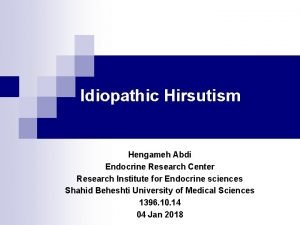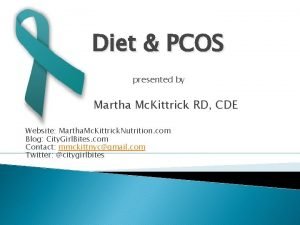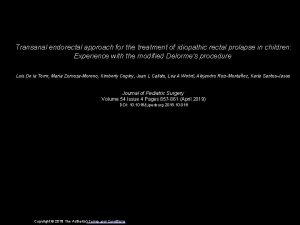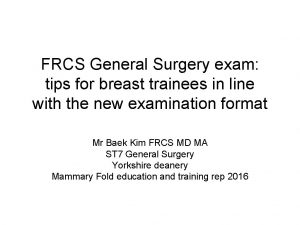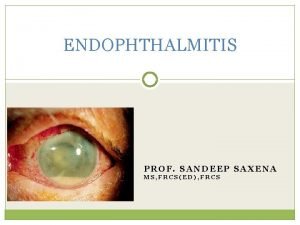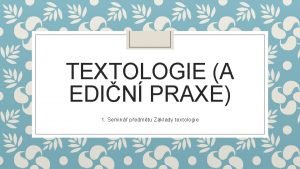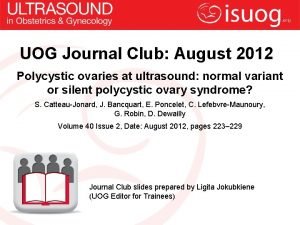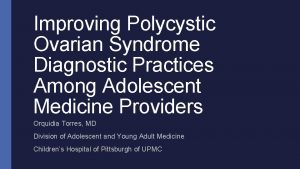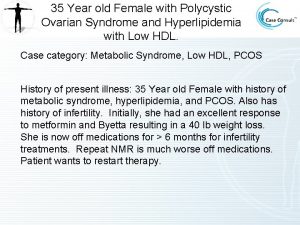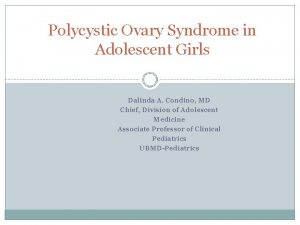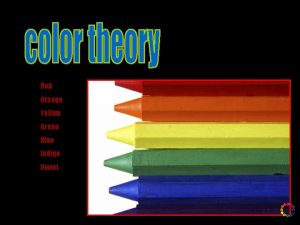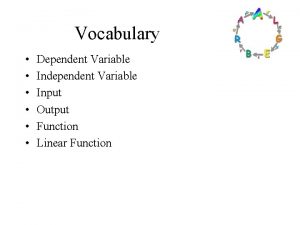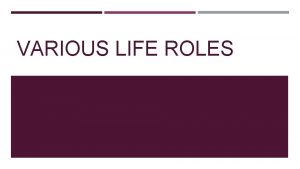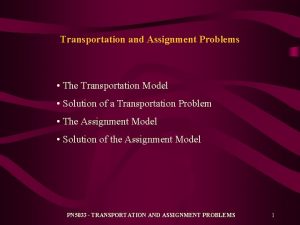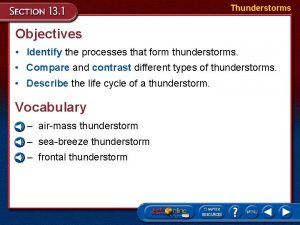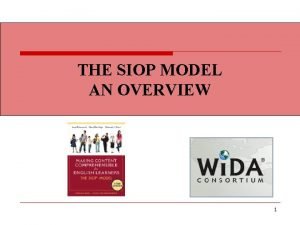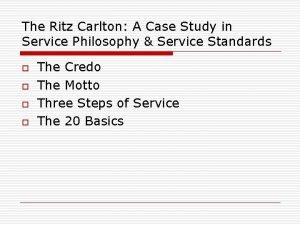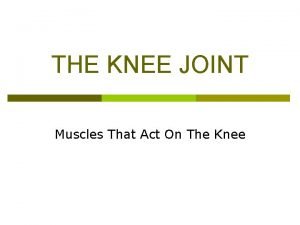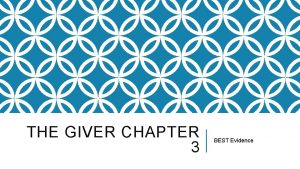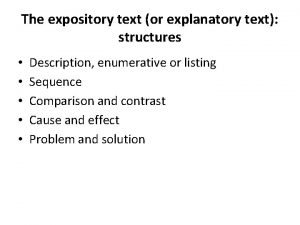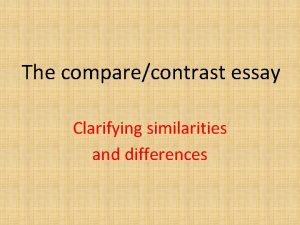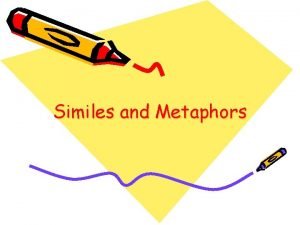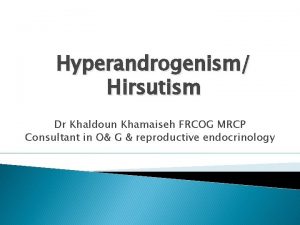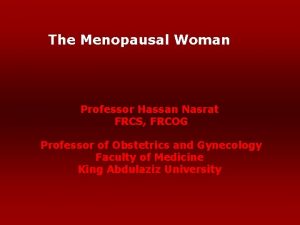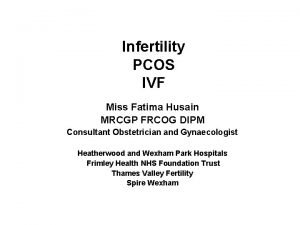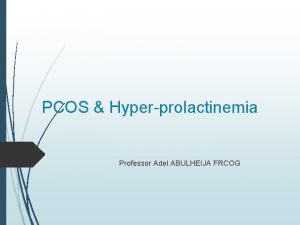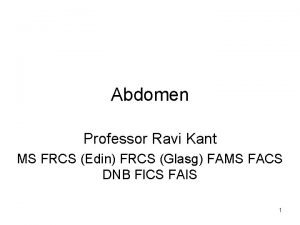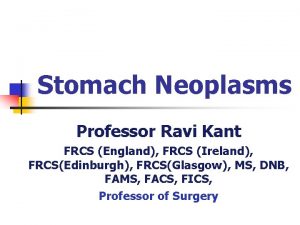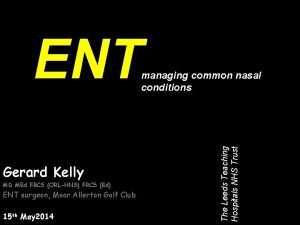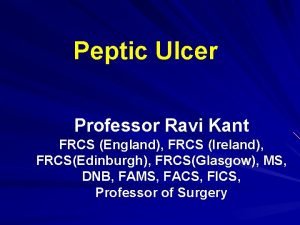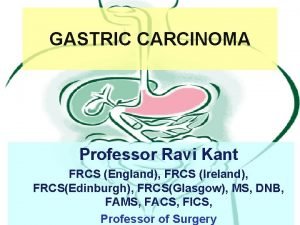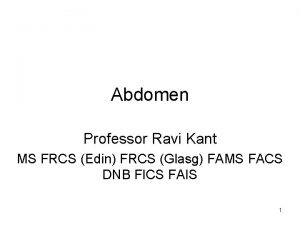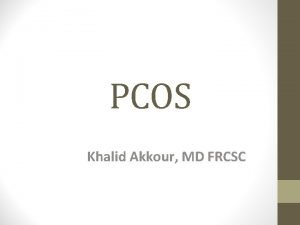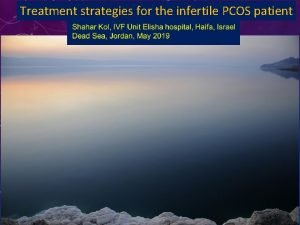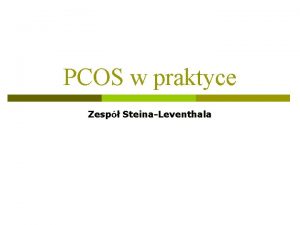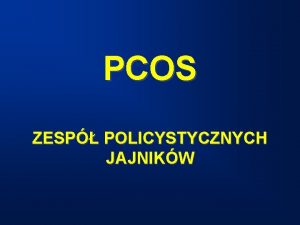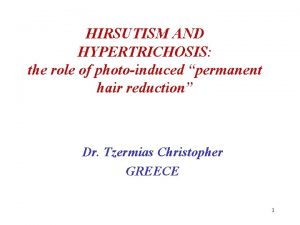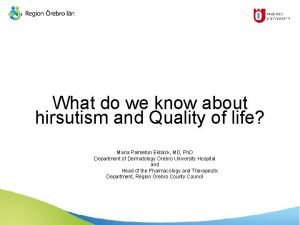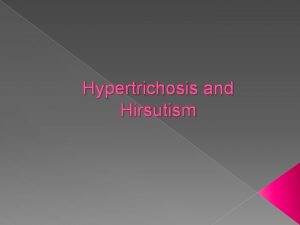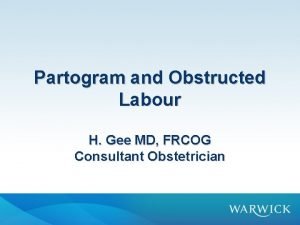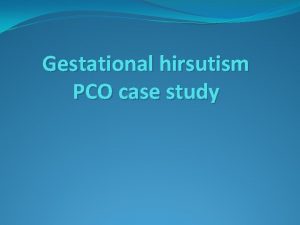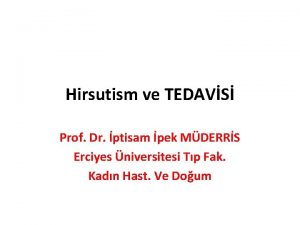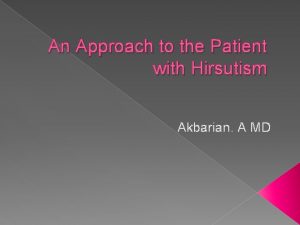PCOS and HIRSUTISM G I Serour FRCOG FRCS
































































- Slides: 64

PCOS and HIRSUTISM G. I. Serour, FRCOG, FRCS, FACOG, FSOGC, FJSOG, FIFFS, FISOG, FEBCOG, (Hon. ) Professor of Obstetrics and Gynaecology, Director, International Islamic Center for Population Studies and Research, Al-Azhar University Clinical Director, The Egyptian IVF-ET Center, Maadi, Cairo, Egypt FIGO Past President EBCOG/TSOG Joint Congress, Antalya, Turkey 17 th – 21 st May 2017 11/23/2020 1

Conflict of interest I declare I have no conflict of interest in this presentation. 11/23/2020 2

Items Addressed v. Androgens production in women. v. Hyperandrogenism in PCOS. v. Hirsutism. v. Evaluation of Hirsutism. v. Management of Hirsutism. 11/23/2020 3

PCOS is a heterogeneous syndrome, not a disease. Patients with PCOS have a set of phenotypic characteristics but lack a single defining element or “gold standard” on which the diagnosis could be anchored. 4

PCOS Phenotypes Phenotype OA HA PCOM A Yes Yes B Yes NO C No Yes D Yes No Yes Dewailly D, et al 2006 J Clin Endocrinol Metab 91(10): 3922 -7. 11/23/2020 5

Some authors questioned whether it is appropriate to apply the definition of PCOS in the absence of overt hyperandrogenism and called for a need for a rethink of diagnostic criteria for PCOS Dewailly D 2016 Best practice and Research clinical Obst&Gynec. 37, 5 -11, 2016 6

Androgen Production in women Androgens are produced primarily from dietary cholesterol that circulates in the form of low-density Lipoproteins (LDL) in the plasma. Gwynne JT, Strauss JF. The role of lipoproteins in steroidogenesis and 11/23/2020 7 cholesterol metabolism in steroidogenic glands. Endocr Rev. 1982: 3: 299 -329.

Testosterone In the circulation testosterone is present as the free or conjugated testosterone. The free portion of testosterone is biologically active and is very small in amount. -Depleski D, Rosenfield RL: Role of hormones in pilosebaceous unit development [review]. Endocr Rev 2000; 21: 363 -392. -Azziz R, Carmina E, Sawaya ME: Idiopathic hirsutism [review]. Endocr Rev 2000; 21: 347 -362. 8

Conjugated Testosterone Almost 98 -99% of plasma testosterone is bound to steroid hormone-binding globulin (SHBG), to cortisol-binding globulin or nonspecifically to albumin and other proteins and is biologically inactive. -Depleski D, Rosenfield RL: Role of hormones in pilosebaceous unit development [review]. Endocr Rev 2000; 21: 363 -392. -Azziz R, Carmina E, Sawaya ME: Idiopathic hirsutism [review]. Endocr Rev 2000; 21: 347 -362. 9

Sources of Androgen in women Ovaries & Adrenals In women, androgens are secreted in almost equal quantities by the ovaries * 35 -40% and adrenal glands 40% and the enzymes involved in the steroidgenesis pathway are similar**. * Carmina E (2006). Ovarian and adrenal hyperandrogenism Ann NY Acad Soc. 2006: 1092: 130 -7. **Miller WL, Aushus RJ. (2011). The molecular biology, biochemistry and physiology of human steriodogenesis and its disorders. End. Rev 2011; 32: 81 -151. 11/23/2020 10

Liver/ Skin/ Adipose Tissue Peripheral conversion of androgenic prohormones to testosterone occurs in the liver, genital skin, hair follicles, and adipose tissue. -Depleski D, Rosenfield RL: Role of hormones in pilosebaceous unit development [review]. Endocr Rev 2000; 21: 363 -392. -Azziz R, Carmina E, Sawaya ME: Idiopathic hirsutism [review]. Endocr Rev 2000; 21: 347 -362. - Papadopoulos V et al. Steroid biosynthesis in adipose tissue steroids. 2015; 103: 89 -104 11

Androgenic Prohormones and Hormones In women, the major circulating androgens or proandrogens in a descending order of serum concentration are: 1 - Dehydroepiandrosterone sulphate (DHEAS), 2 - Dehydroepiandrosterone (DHEA), 3 - Androstenedione (AT), 4 - Testosterone (T) / /has strong affinity to AR 5 - Dihydrotestosterone (DHT)/ 12

Androstenedione (AT), derived from the ovaries and adrenals, is the most important precursor of T while DHEAS and DHEA, derived almost exclusively from the adrenals, account for only 5% and 13% of circulating T among women of reproductive age respectively. Longcape C. Adrenal and Gonadol androgen secretion in normal females. Clin. Endocrinol. Metab. (1986): 15 (2) 213 -228. 13

Estrogen/ Androgens/ SHBG Estrogens increase androgens decrease the production of SHBG in the liver. In hyperandrogenic condition, the SHBG is decreased thus allowing higher levels of free testosterone. 14

Insulin/ SHBG Insulin decreases the production of SHBG. In condition of insulin resistance and compensatory hyperinsulinemia, the production of SHBG is decreased and this leads to higher levels of free testosterone. 15

In the hair follicles, testosterone is converted to its biologically active form, dihydrotestosterone, by the enzyme. 5α- reductase. -Depleski D, Rosenfield RL: Role of hormones in pilosebaceous unit development [review]. Endocr Rev 2000; 21: 363 -392. -Azziz R, Carmina E, Sawaya ME: Idiopathic hirsutism [review]. Endocr Rev 2000; 21: 347 -362. 16

Hyperandrogenism in PCOS Studies with ovarian theca cells taken from women with PCOS have demonstrated increased androgen production due to increased CYP 17 A 1 and HSD 3 B 2 enzyme activities that produce androgens from cholesterol. 11/23/2020 Yong EL et al 1992 Clin. Endocrinol: 37: 51 -58 17

In women the most common cause of hyperandrogenism is PCOS. Ovarian theca cells increased androgen production in response to chronically elevated LH and high insulin levels are the causes of this hyperandrogenism. 18

Hyperinsulinemia promotes androgen biosynthesis via insulin receptor and to a lesser extent, the insulin-like growth factor-1 (IGF. 1) receptor on theca cells and increases levels of circulating free testosterone by suppressing hepatic production of steroid hormone binding globulin SHBG. - Landy M , Huang A, Azziz R. Degree of hyperinsulinemia, independent of androgen levels, is an important determinant of the severity of hirsutism in PCOs. Fertil and Steril, 2009; 92 (2): 643 -7. - Ovalle F, Azziz R. Insulin resistance, PCOs and type 2 diabetes mellitus. Fertil&Steril 2002; 77 (6): 1095 -105. 19

Hyperandroginsim - Hirsutism While androgen excess will contribute to the ovulatory and menstrual dysfunction of PCOS patients the most recognizable sign of hyperandrogenaemia includes hirsutism, acne androgenic alopecia or female pattern hair loss. 11/23/2020 20

Normal Pattern of Hair distribution Vellus Hair Adults have two types of hair, vellus and terminal. Vellus hair is soft, fine, generally colorless, and usually short. 11/23/2020 21

Vellus Hair Vellus hair covers the face, chest, and back and gives the impression of “hairless” skin. 11/23/2020 22

Terminal Hair 11/23/2020 Terminal hair is long, coarse, dark, and sometimes curly. 23

Terminal hair grows on the scalp, pubic, and armpit areas in both men and women. 11/23/2020 24

Excessive hair that is due to genetic and ethnic variation rather than hormonal causes is typically located on the arms, hands, legs, and feet. 11/23/2020 25

If excessive hair growth is present only on the lower legs and forearms, it is not considered hirsutism and will not respond to hormonal therapy. 11/23/2020 26

If hair follicles are hormonesensitive, androgens may cause some vellus hairs to change to terminal hairs and cause the terminal hairs to grow faster and thicker. 11/23/2020 27

Clinical Diagnosis of Hirsutism in PCOS Hirsutism due to hormonal causes is the excessive growth of coarse dark hair on the face, chest, abdomen, back upper arms or upper legs of women* and PCOS is the most common etiology of hirsutism**. *American society of Reproductive Medicines (ASRM) 2016. Hirsutism and PCOS. A guide for patients, 2016. r 28 **Spritzer PM et al. 2016. Curr. Pharm 2016; 22 (36): 5603 -5613.


The prevalence of hirsutism in PCOS ranges from 70 to 80%, vs. 4% to 11% in women in the general population. Spritzer PM et al. 2016. Hirsutims in PCOS. Pathophysiology and Management. 11/23/2020 30

Evaluation of Hirsutism is usually evaluated by scoring facial and body terminal hair growth using the modified Ferriman-Gallwey method. However, the hirsutism score correlates poorly with serum androgens. 11/23/2020 Haung A et al 2006, Fertil & Steril: 86 S 12 -S 31

Biochemical Assessment § Total and free testosterone (High normal) § Serum LH elevated. § LH/FSH higher than 3. § Dehydro-epiandrosterone Sulphate (DHEAS) (marginal elevation). § Prolactin level (mildly elevated in 30% PCOS. 11/23/2020 32

Ultrasound Evaluation Ultrasound evaluation of the ovaries, adrenals or both may be useful for screening if symptoms or biochemical levels suggest the presence of neoplasm. 11/23/2020 33

Differential Diagnosis of hyperandrogenic Patient • Idiopathic hirsutism. • Hyper-androgenic insulin-resistant acanthuses nigrican (HAIRAN) syndrome. • 21 -hydroxylase-deficient non-classic congenital adrenal hyperplasia. • Classic congenital adrenal hyperplasia. • Androgen-secreting neoplasm. • Side effects of medication. • Cushing disease. • Hypothyroidism. • Hyper-prolactinaemia. - Azziz R et al 2004 J. Clin Endrocrinola. Metab: 89(2) 453 -62 11/23/2020 - Lergo RS et al 2013. J Clin. Endocrinol Metab: 98(12)4565 -92. 34

Management of Hirsutism in PCOS Hirsutism is a sign, not a disease of itself and PCOS is the most common etiology and found in 72% to 82% of patients with hyperandrogenism. Azziz R et al 2004 J. Clin Endrocrinola. Metab: 89(2) 453 -62 11/23/2020 35

The patient needs to be assessed and evaluated. Treatment should be patient centered whether for hirsutism only or hirsutism and anovulation, anovulatory bleeding, desire to get pregnant or metabolic comorbidities. 11/23/2020 36

Initiation of treatment should be based on the patient’s perception of hirsutism rather than the quantitative characteristics of hirsutism. Martin KA et al 2008 J. Clin Endocrinol Metab. 93(4) 1105 -20. 11/23/2020 37

Furthermore monitoring of T and other androgens during treatment is generally unnecessary as the hirsutism score correlates poorly with serum androgens. Legro RS et al 2010 J Clin Endocrinol Metab. 95(12) 5305 -13. 11/23/2020 38

Modification of life style smoking Smoking cessation is strongly recommended for hirsute patients as many of the undesirable side effects of the medications prescribed to treat hirsutism are exacerbated when patients indulge in smoking. 11/23/2020 Escobar-Morreale HF et al 2012 Hum. Reprod. Update. 18(2): 146 -70. 39

Weight Loss A systematic review of six small RCTs observed that lifestyle modification was beneficial in the reduction of serum androgens and increased SHBG, along with some improvement in hirsutism as achieved by the m. FG Score. Moran LJ et al 2011, Cochrane Database Syst Review (7) CD 007506. 11/23/2020 40

Medication The management of hirsutism due to PCOS involves primarily either androgen suppression, with a hormonal combination contraceptive or androgen blockade as with androgen receptor blocker or a 5α reductase inhibitor or a combination of the above. Yong EL 2016 Best Practice and Research Clinical Obstet and Gynecol 37: 1 -4. 11/23/2020 41

Androgen Suppression Hormonal Combination contraceptives HCCs - Progestins in HCCs cause suppression of LH levels and inhibition of LH-mediated ovarian androgen synthesis* - Ethinylestrodial in HCCs leads to significant increase in SHBG, thereby contributing to a reduction of free T **. - HCCs decrease the synthesis and release of androgens by the adrenal. *** *Archer DF et al 2009 Contraception 80 (3): 245 -53. ** Vrbikova J et al 2005, Hum. Reprod Update. 11(3): 277 -91. 11/23/2020 *** Madden JD et al 1978 Am. J Obstet Gynecol. 132(4): 380 -4. 42

- 60 -100% of women with hirsutism demonstrate improvement on oral HCCs *. - 21 day active 7 day placebo provides better ovarian suppression compared to continuous regimen** * Burkman JR RT 1995, Am. J M Med 98(1 A) S 130 -5. ** Legro RS et al 2008, J. Clinical Endocrinol Metab 93 (2): 420 -9. 11/23/2020 43

HCCs with Antiandrogenic Progestins - Cyproterone acetate (CPA). - Chlormadinone acetate (CMA). - Drospirenone (DRSP). - Dienogest (DNG). Comparative studies of HCCs containing progestin with antiandrogenic properties are limited. Lizneva D et al 2016, Best Practice and Research Clinical Obstet and gynecol 37: 98 -118. 11/23/2020 44

Antiandrogens Monotherapy Androgen Receptor Blockers - Spironolactone. Flutamide. Cyproterone acetate. 5 α reductase inhibitor. Antiandrogens have not been used with any regularity in women, all are teratogenic and their use is generally discouraged. Lizneva D et al 2016, Best Practice and Research Clinical Obstet and gynecol 37: 98 -118. 11/23/2020 45

Combined Treatment of Antiandrogens with HCCs Four RCTs demonstrated that antiandrogens in combination with HCCs were more effective than monotherapy with HCCs. 11/23/2020 Swiglo BA et al 2008 J Clin Endocrinol Metab. 93 (4): 1153 -60. 46

Why antiandrogen+HCCs? - Efficacy is generally higher when using a combination of HCCs and antiandrogens than with either HCCs or antiandrogen monotherapy, - HCCs minimize the risk of teratogenicity. It is advisable to begin therapy with a combination of HCCs and antiandrogens. Lizneva D et al 2016, Best Practice and Research Clinical Obstet and gynecol 37: 98 -118. 11/23/2020 47

Gn. RHa and Insulin Sensitizers Several studies have demonstrated the superior efficiency of HCCs monotherapy compared to Gn. RHa* and insulin sensitizers ** * Heiner JS et al 1995 J Clin Endocrinology Metab. 80(12) 3412 -8. ** Costello M et al 2007 Cochrane Database Syst Review (1) CD 005552. 11/23/2020 48

Metformin If HCCs are contraindicated, mainly in the presence of insulinresistance related comorbidities, a second-line option for reducing androgen secretion may be metformin associated with lifestyle changes. 11/23/2020 49

Combined Treatment of Antiandrogen with Metformin In a small RCT, flutamide in combination with metformin appeared to be superior to monotherapy. Koulouri O et al 2008 Clin Endocrinol (Oxf) 68 (5): 800 -5. 11/23/2020 50

Cosmotic Approaches Cosmotic treatment hirsutism should be combined with medical treatment and is widely used and categorized as short and long term approaches. Yong EL 2016 Best Practice and Research Clinical Obstet and Gynecol 37: 1 -4. 11/23/2020 51

Short Term Methods - Shaving. - Chemical depilation. - Plucking (threading). - Waxing. - Bleaching. - Eflornithine hydrochloride. 11/23/2020 52

Depilation/Epilation - Depilation is the removal of the hair shaft from skin’s surface as shaving and chemical depilation. - Epilation is the extraction of hair above the bulb (eg plucking, waxing). It provides the most long lasting action on hair regrowth with hair absent for 6 -8 weeks. 11/23/2020 Ramos-e-Silva M et al 2001 Clin Dermatol 19 (4) 437 -44. 53

Eflornithine Hydrochloride Cream Topical application of 13. 9% eflornithine hydrochloride for facial hirsutism inhibits the enzyme ornithine decarboxylase which is required for the growth and differentiation of cells in the hair follicle, it requires daily use and hirsutism relapses after 8 weeks of cessation of treatment, and not approved for large surface area. Wolf Jr JE et al. , 2007 Int J Dermatol 46(1): 94 -8. 11/23/2020 54

Long Term Approaches - Electrolysis. - Laser therapy. - Intense pulse light (IPL). Martin KA 2008 An Endocrine Society Clinical Practice Guideline J. Clin Endocrinol Metab 93(4): 1105 -20. 11/23/2020 55

Conclusion Treatment of hirsutism takes time and absolute cure is rarely possible and relapse may follow cessation of medical treatment. 11/23/2020 56

The majority of experts recommend lifelong treatment with maximum suppression for approximately 2 years. 11/23/2020 57

Depending on the progression of hirsutism antiandrogens may be reduced or stopped while continuing oral HCCs. 11/23/2020 58

Monitoring and treatment for metabolic complications or associated infertility with PCOS are necessary. 11/23/2020 59

In all cases, strong clinical support is crucial to ensure treatment adherence and success. 11/23/2020 60

30 th November – 1 st December 2017 Cairo- Marriott hotel Zamalek 11/23/2020 For more info. Please contact Conference Secretariat. 10 Al Mesaha St. Dokki-Giza E-mail: efsociety 1@hotmail. com - website: www. efss-egypt. com 61


i c あり THANK YOU cias 11/23/2020 謝 ¡gra e 謝 が とう r e M Gr azi ﺷﻜﺮﺍ 63

Furthermore, overexpression of DENND 1 A variant 2 in theca cells of women with PCOS resulted in a PCOS phenotype with increased androgen production. Indran IR et al 2016. Best Practice and Research, Clinical Obstet & Gynecol, 37: 12 -14, 2016 64
 Idiopathic hirsutism
Idiopathic hirsutism Hirsutism
Hirsutism Idiopathic hirsutism
Idiopathic hirsutism Alpine course frcs
Alpine course frcs Frcsed meaning
Frcsed meaning Titul frcs(t)
Titul frcs(t) Pcos testing
Pcos testing Pcos ultrasound report
Pcos ultrasound report Pcos macros
Pcos macros Normoz tablet for weight loss
Normoz tablet for weight loss Is byetta used to treat pcos
Is byetta used to treat pcos Ferriman-gallwey scale
Ferriman-gallwey scale Red pink yellow purple green and blue
Red pink yellow purple green and blue And because i am happy and dance and sing
And because i am happy and dance and sing Compare and contrast west side story and romeo and juliet
Compare and contrast west side story and romeo and juliet Taller and younger shorter and older
Taller and younger shorter and older Reading and writing money in symbols and in words
Reading and writing money in symbols and in words Red, orange, yellow, green, blue, indigo and violet.
Red, orange, yellow, green, blue, indigo and violet. Gabby and sydney bought some pens
Gabby and sydney bought some pens Young and dyslexic summary
Young and dyslexic summary What did the sibley commission do
What did the sibley commission do West yorkshire and harrogate health and care partnership
West yorkshire and harrogate health and care partnership Compare and contrast transverse and longitudinal waves
Compare and contrast transverse and longitudinal waves Compare and contrast spring and neap tides.
Compare and contrast spring and neap tides. Identify the independent variable and dependent variable
Identify the independent variable and dependent variable Lesson 5 verbs action (transitive/intransitive) answer key
Lesson 5 verbs action (transitive/intransitive) answer key Defination of life role
Defination of life role Maintenance of record and report
Maintenance of record and report Transportation and assignment problems
Transportation and assignment problems Compare and contrast cold wave and wind chill factor
Compare and contrast cold wave and wind chill factor Trading account vertical format
Trading account vertical format Lesson preparation siop
Lesson preparation siop Macbeth tomorrow speech
Macbeth tomorrow speech The ritz carlton credo
The ritz carlton credo Conglomerates and franchises 1950s
Conglomerates and franchises 1950s Mieniscus
Mieniscus Facts about gatsby in chapter 3
Facts about gatsby in chapter 3 The giver chapter 3 quiz
The giver chapter 3 quiz Explanatory text structure
Explanatory text structure Definition of compare/contrast
Definition of compare/contrast Compare and contrast analog and digital forecasting
Compare and contrast analog and digital forecasting The boy in the striped pyjamas film analysis
The boy in the striped pyjamas film analysis The blind man and the elephant poem questions
The blind man and the elephant poem questions Disadvantages of hub and spoke system
Disadvantages of hub and spoke system Comparison text structure
Comparison text structure Input output and form design
Input output and form design The theme of the most dangerous game
The theme of the most dangerous game Simple predicates
Simple predicates Compound inequality and
Compound inequality and Soldering brazing welding
Soldering brazing welding Winter poem with simile and metaphor
Winter poem with simile and metaphor How are similarities passed from parent to offspring
How are similarities passed from parent to offspring Separation of powers and checks and balances
Separation of powers and checks and balances Security program and policies principles and practices
Security program and policies principles and practices Absolute max
Absolute max Megan and ron ate too much
Megan and ron ate too much Rounding numbers 5
Rounding numbers 5 Theme of love in romeo and juliet
Theme of love in romeo and juliet Protagonist and antagonist in romeo and juliet
Protagonist and antagonist in romeo and juliet Irony in romeo and juliet act 4
Irony in romeo and juliet act 4 Richard nixon tricky dicky
Richard nixon tricky dicky Soldiers before and after war
Soldiers before and after war Probably armed possibly not
Probably armed possibly not Are negative decimals rational numbers
Are negative decimals rational numbers Orange yellow green
Orange yellow green
